Native Legume, Tarwi, Feeds Cuzco

Cuzco, like the rest of the Andes, has food plants that are new to the rest of the world. The potato came from here and it changed the course of the world with what it offered. But there are others, such as a little yellowish seed that is capable of soothing hunger and nourishing the body in a natural and healthy way called tarwi.
Also called chocho, tarwi is a member of the lupine family (lupinus mutabilis)and is native to the Andes of Bolivia, Ecuador and Peru where it has been an important food since Pre-Hispanic times. Its high level of proteins, more even that soy beans, makes it a very useful plant in the long run for consumption in other regions of the world.
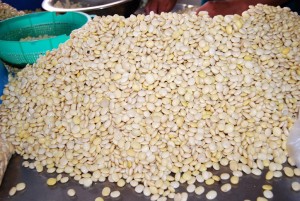
According to Wikipedia, Tarwi is extraordinarily nutritious for both humans and livestock.
Tarwi is considered appropriate for children in the growth stage, pregnant women, or lactating women. When combined with other cereals, such as quinoa or amaranth (also native to the Cuzco area) tarwi makes for a very nutritious product. In industry tarwi flour is used up to 15% of the total for making bread because of its value in improving considerably caloric and protein value. […]
Proteins and fat constitute more than half their weight. A study of 300 different genotypes shows the seeds to vary between 41 and 51% in protein content. Fat (which is inversely proportional to the protein content) varies from 24 to 14%. By removing the external skin from the seed and grinding the grain a flour is obtained that is 50% protein. Tarwi’s protein has adequate quantities of the amino acids lysine and cysteine but has only 23-30% of the methionine needed for the optimal growth of animals.
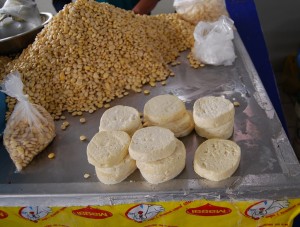
Unfortunately, in the cities of the Andean region people eat less tarwi as they modernize. But in rural areas its use remains high; it is a staple. The city of Cuzco follows this pattern. Tarwi is primarily consumed, despite its history and great value, by the population that has immigrated from rural areas to the city, although the chefs propagating Novo-Andean cooking find it useful.

People in the cities seem to prefer the new and modern and not something that, as many say, “huele al campo¨–smells like the countryside. However, these newer products do not have the nutritional value of traditional Andean foods, such as tarwi.
This phenomenon is also due to the customs of each place. Often people think that by eating Andean products they are dropping down the social ladder, even though the Andean foods are better for them. Unfortunately, this is just a measure of our lack of knowledge.
Tarwi does have one difficulty. The seed in its raw form is not digestible. It requires processing in water for a day or so to remove the soluble bitters that impede its use. However the wet tarwi sold in the market places of Cuzco has already been processed and is ready for use.
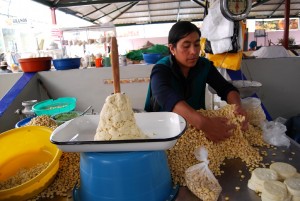
In Cuzco women from rural areas will obtain tarwi in its whole form to set it aside in small portions for their children as a replacement for expensive and not very nourishing industrial snacks. such as potato and tortilla chips as well as cheezies.
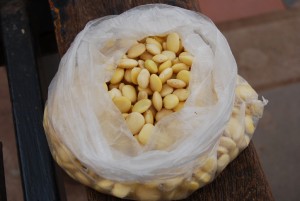
In many families as well as in the markets it is almost always part of the daily offerings. One finds it in ground form as an accompaniment to various meats in the main dishes and as a whole grain in soups.
The acquisition of this legume is carried out in the various popular markets of Cuzco, more than in its supermarkets. Tarwi is offered in two forms. One can buy it as a whole grain or pre-ground, depending on what one wishes to prepare.
The preparation of tarwi varies since their are different ways to consume it. For example, one can make a ceviche of tarwi or a succulent stew also prepared with tarwi.
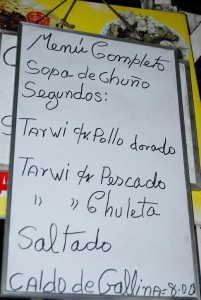
The traditional way of eating it in the city of Cuzco is as a puree to accompany boiled potatoes (called “harinosas” or floury) and cheese, or one can serve it as a cream to accompany rice, chuño (freeze dried potatoes), fried yuca, fired egg, or a main dish such as a stir fry of meat, beef stew, fried fish, etc.
We can also find whole tarwi in vegetable soups or in a tasty squash locro (soup). The use of tarwi varies according to the creativity of the cooks.
We should not consider tarwian ordinary grain but rather a rock star of the table because of its great nutritional value.
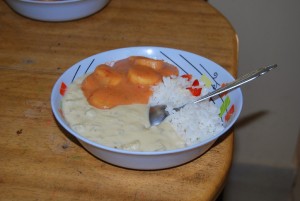
Because of this great value, we offer below a traditional recipe for the use of tarwi.
Tarwi Puree
(for three people)
1/2 kilo of ground tarwi (one can buy the tarwi whole and grind it if desired)
1 clove garlic
1 onion.
1/2 kilo boiling potatoes (harinosas)
1 bundle of huacatay
1 big slice of cheese to your taste.
salt as desired.
Preparation.
To begin, mash the garlic and then lightly toast it in a little vegetable oil with salt in the same pan where you plan to make the puree. Add the finely diced onion and fry it until soft and lightly golden. Add the diced potatoes and water to cover them. Boil until cooked. Then add the ground tarwi and grated cheese and mix thoroughly mashing the potatoes until after a few minutes you obtain the consistency of puree you desire. After removing from the flame and turning off the burner, as a final act, we add finely diced or julienned huacatay as a dusting over the top to taste and then we serve the tarwi to enjoy.





Thanks for the info, I have visited Cuzco 3 weeks ago and I could only eat traditional food at San Pedro market.